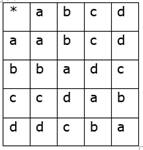Consider the binary operation * and 0 defined by the following tables on set S = {a, b, c, d}.

We observe the following:
a * b = b * a = b
c * a = a * c = c
a * d = d * a = d
b * c = c * b = d
b * d = d * b = c
c * d = d * c = b
There ‘ * ’ is commutative.
Also,
a * (b * c) = a * (d) = d (From above)
(a * b) * c = (b) * c = d (Also from above)
Hence, ‘ * ’ is associative too.
Therefore, to find the identity element, e for e belong to S, we need:
a * e = e * a = a, a belong to S.
Therefore, a * e = a
![]() e = a (since, a * a = a, from the given table)
e = a (since, a * a = a, from the given table)
To find out the inverse, a * x = e = b * x, x belongs to S
![]() a * x = e
a * x = e
![]() x = a (From the given table)
x = a (From the given table)
Therefore, the inverse of a is a, b is b, c is c and d is d.
9